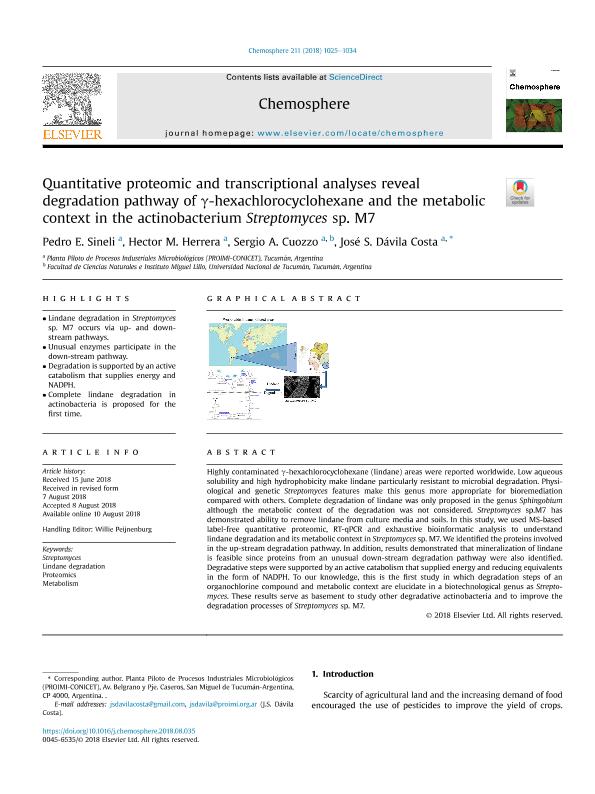Mostrar el registro sencillo del ítem
dc.contributor.author
Sineli, Pedro Eugenio

dc.contributor.author
Herrera, Héctor Matías
dc.contributor.author
Cuozzo, Sergio Antonio

dc.contributor.author
Dávila Costa, José Sebastián

dc.date.available
2019-10-18T12:51:49Z
dc.date.issued
2018-07
dc.identifier.citation
Sineli, Pedro Eugenio; Herrera, Héctor Matías; Cuozzo, Sergio Antonio; Dávila Costa, José Sebastián; Quantitative proteomic and transcriptional analyses reveal degradation pathway of γ- hexachlorocyclohexane and the metabolic context in the actinobacterium Streptomyces sp. M7; Pergamon-Elsevier Science Ltd; Chemosphere; 211; 7-2018; 1025-1034
dc.identifier.issn
0045-6535
dc.identifier.uri
http://hdl.handle.net/11336/86283
dc.description.abstract
Highly γ-hexachlorocyclohexane (lindane) contaminated areaswere reported worldwide. Low aqueous solubility and high hydrophobicitymake lindane particularly resistant to microbial degradation.Physiological and genetic Streptomyces features make this genus moreappropriate for bioremediation compared with others. Complete degradationof lindane was only proposed in the genus Sphingobium although themetabolic context of the degradation was not considered. Streptomyces sp.M7 has demonstrated ability to remove lindane from culture media andsoils. In this study, we used MS-based label-free quantitative proteomic,RT-qPCR and exhaustive bioinformatic analysis to understand lindanedegradation and its metabolic context in Streptomyces sp. M7. Weidentified the proteins involved in the up-stream degradation pathway. Inaddition, results demonstrated that mineralization of lindane is feasiblesince proteins from an unusual down-stream degradation pathway were alsoidentified. Degradative steps were supported by an active catabolism thatsupplied energy and reducing equivalents in the form of NADPH. To ourknowledge, this is the first study in which degradation steps of anorganochlorine compound and metabolic context are elucidate in abiotechnological genus as Streptomyces. These results serve as basementto study other degradative actinobacteria and to improve the degradationprocesses of Streptomyces sp. M7.
dc.format
application/pdf
dc.language.iso
eng
dc.publisher
Pergamon-Elsevier Science Ltd

dc.rights
info:eu-repo/semantics/openAccess
dc.rights.uri
https://creativecommons.org/licenses/by-nc-sa/2.5/ar/
dc.subject
STREPTOMYCES
dc.subject
LINDANE
dc.subject
PROTEOMIC DEGRADATION
dc.subject
METABOLISM
dc.subject.classification
Bioquímica y Biología Molecular

dc.subject.classification
Ciencias Biológicas

dc.subject.classification
CIENCIAS NATURALES Y EXACTAS

dc.title
Quantitative proteomic and transcriptional analyses reveal degradation pathway of γ- hexachlorocyclohexane and the metabolic context in the actinobacterium Streptomyces sp. M7
dc.type
info:eu-repo/semantics/article
dc.type
info:ar-repo/semantics/artículo
dc.type
info:eu-repo/semantics/publishedVersion
dc.date.updated
2019-10-16T19:39:55Z
dc.journal.volume
211
dc.journal.pagination
1025-1034
dc.journal.pais
Estados Unidos

dc.journal.ciudad
Amsterdam
dc.description.fil
Fil: Sineli, Pedro Eugenio. Consejo Nacional de Investigaciones Científicas y Técnicas. Centro Científico Tecnológico Conicet - Tucumán. Planta Piloto de Procesos Industriales Microbiológicos; Argentina
dc.description.fil
Fil: Herrera, Héctor Matías. Consejo Nacional de Investigaciones Científicas y Técnicas. Centro Científico Tecnológico Conicet - Tucumán. Planta Piloto de Procesos Industriales Microbiológicos; Argentina
dc.description.fil
Fil: Cuozzo, Sergio Antonio. Consejo Nacional de Investigaciones Científicas y Técnicas. Centro Científico Tecnológico Conicet - Tucumán. Planta Piloto de Procesos Industriales Microbiológicos; Argentina
dc.description.fil
Fil: Dávila Costa, José Sebastián. Consejo Nacional de Investigaciones Científicas y Técnicas. Centro Científico Tecnológico Conicet - Tucumán. Planta Piloto de Procesos Industriales Microbiológicos; Argentina
dc.journal.title
Chemosphere

dc.relation.alternativeid
info:eu-repo/semantics/altIdentifier/url/https://www.sciencedirect.com/science/article/pii/S0045653518315108?via%3Dihub
dc.relation.alternativeid
info:eu-repo/semantics/altIdentifier/doi/https://doi.org/10.1016/j.chemosphere.2018.08.035
Archivos asociados
